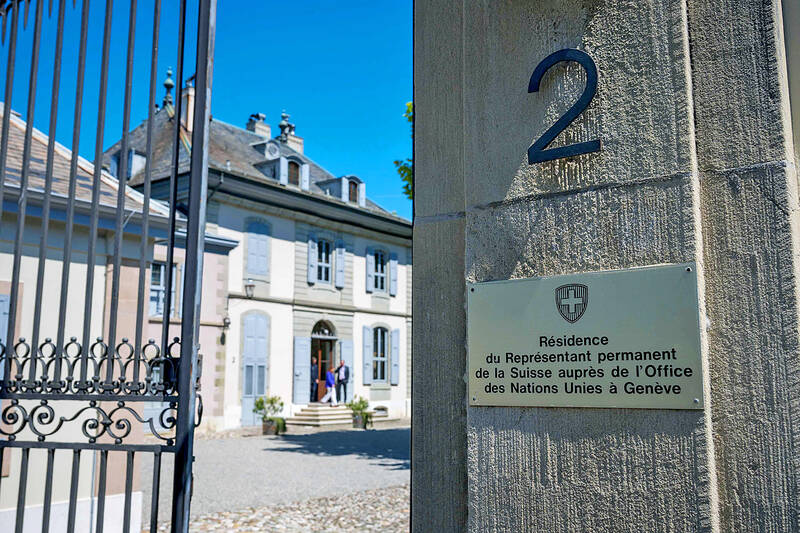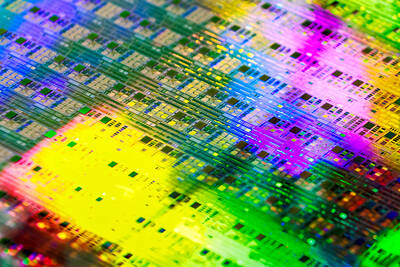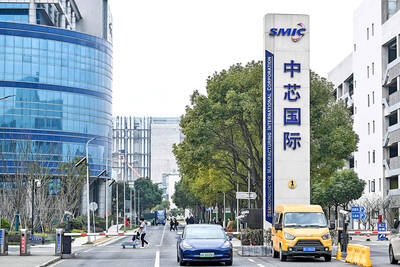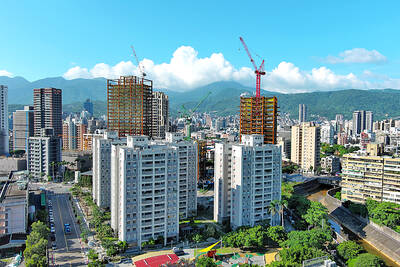US President Donald Trump hailed a “total reset” in US-China trade relations, ahead of a second day of talks yesterday between top officials from Washington and Beijing aimed at de-escalating trade tensions sparked by his aggressive tariff rollout.
In a Truth Social post early yesterday, Trump praised the “very good” discussions and deemed them “a total reset negotiated in a friendly, but constructive, manner.”
The second day of closed-door meetings between US Secretary of the Treasury Scott Bessent, US Trade Representative Jamieson Greer and Chinese Vice Premier He Lifeng (何立峰) were due to restart yesterday morning, said a person familiar with the talks who was not authorized to speak publicly.

Photo: AFP
“These talks reflect that the current state of the trade relations with these extremely high tariffs is ultimately in the interests of neither the United States nor China,” Citigroup Inc global chief economist Nathan Sheets said, calling the tariffs a “lose-lose proposition.”
The discussions are the first time senior officials from the two countries have met face-to-face to tackle the thorny topic of trade since Trump slapped steep new levies on China last month, sparking robust retaliation from Beijing.
The levies on China currently total 145 percent, with cumulative US duties on some Chinese goods reaching a staggering 245 percent.
In retaliation, China put a 125 percent tariff on US goods, cementing a near trade embargo between the two countries.
Ahead of the meeting, Trump signaled he might lower the tariffs, suggesting on social media that an “80% Tariff on China seems right!”
However, his press secretary Karoline Leavitt later clarified that the US would not lower tariffs unilaterally, and that China would also need to make concessions.
The first day of negotiations occurred on Saturday at the residence of the Swiss ambassador to the UN in Geneva.
Going into the meeting, both sides played down expectations of a major change in trade relations, with Bessent underlining a focus on “de-escalation” and not a “big trade deal,” and Beijing insisting the US must ease tariffs first.
China’s state news agency Xinhua called the talks “an important step in promoting the resolution of the issue.”
The meeting comes after Trump unveiled a trade agreement with the UK, the first deal with any country since he unleashed his blitz of global tariffs.
The five-page, non-binding deal confirmed to nervous investors that the US is willing to negotiate sector-specific relief from duties, but maintained a 10 percent baseline levy on most British goods.
Following the US-UK trade announcement, analysts have voiced pessimism about the likelihood negotiations would lead to any significant changes in the US-China trade relationship.
“It’s nice that they’re talking. But my expectation for the actual outcomes of this first round of talks is pretty limited,” Sheets said.
The fact the talks are even happening “is good news for business, and for the financial markets,” Peterson Institute for International Economics senior non-resident fellow Gary Hufbauer said.
However, Hufbauer cautioned he was “very skeptical that there will be any return to something like normal US-China trade relations,” with even a tariff rate of 70 to 80 percent still potentially halving bilateral trade.
“I think it’s quite possible they’ll walk away from Geneva saying how constructive and productive the talks were, but not actually reducing tariffs at all,” Hufbauer said.
In his Truth Social post, Trump said the talks had made “GREAT PROGRESS!!”
“We want to see, for the good of both China and the US, an opening up of China to American business,” Trump added.

NO BREAKTHROUGH? More substantial ‘deliverables,’ such as tariff reductions, would likely be saved for a meeting between Trump and Xi later this year, a trade expert said China launched two probes targeting the US semiconductor sector on Saturday ahead of talks between the two nations in Spain this week on trade, national security and the ownership of social media platform TikTok. China’s Ministry of Commerce announced an anti-dumping investigation into certain analog integrated circuits (ICs) imported from the US. The investigation is to target some commodity interface ICs and gate driver ICs, which are commonly made by US companies such as Texas Instruments Inc and ON Semiconductor Corp. The ministry also announced an anti-discrimination probe into US measures against China’s chip sector. US measures such as export curbs and tariffs

The US on Friday penalized two Chinese firms that acquired US chipmaking equipment for China’s top chipmaker, Semiconductor Manufacturing International Corp (SMIC, 中芯國際), including them among 32 entities that were added to the US Department of Commerce’s restricted trade list, a US government posting showed. Twenty-three of the 32 are in China. GMC Semiconductor Technology (Wuxi) Co (吉姆西半導體科技) and Jicun Semiconductor Technology (Shanghai) Co (吉存半導體科技) were placed on the list, formally known as the Entity List, for acquiring equipment for SMIC Northern Integrated Circuit Manufacturing (Beijing) Corp (中芯北方積體電路) and Semiconductor Manufacturing International (Beijing) Corp (中芯北京), the US Federal Register posting said. The

India’s ban of online money-based games could drive addicts to unregulated apps and offshore platforms that pose new financial and social risks, fantasy-sports gaming experts say. Indian Prime Minister Narendra Modi’s government banned real-money online games late last month, citing financial losses and addiction, leading to a shutdown of many apps offering paid fantasy cricket, rummy and poker games. “Many will move to offshore platforms, because of the addictive nature — they will find alternate means to get that dopamine hit,” said Viren Hemrajani, a Mumbai-based fantasy cricket analyst. “It [also] leads to fraud and scams, because everything is now

MORTGAGE WORRIES: About 34% of respondents to a survey said they would approach multiple lenders to pay for a home, while 29.2% said they would ask family for help New housing projects in Taiwan’s six special municipalities, as well as Hsinchu city and county, are projected to total NT$710.65 billion (US$23.61 billion) in the upcoming fall sales season, a record 30 percent decrease from a year earlier, as tighter mortgage rules prompt developers to pull back, property listing platform 591.com (591新建案) said yesterday. The number of projects has also fallen to 312, a more than 20 percent decrease year-on-year, underscoring weakening sentiment and momentum amid lingering policy and financing headwinds. New Taipei City and Taoyuan bucked the downturn in project value, while Taipei, Hsinchu city and county, Taichung, Tainan and Kaohsiung